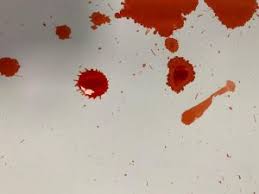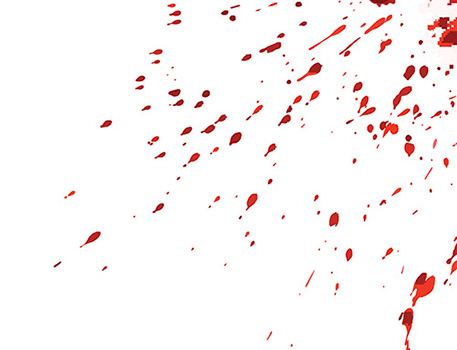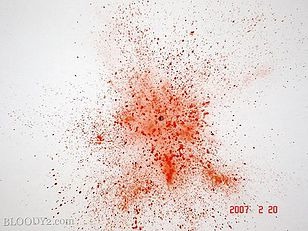Bloodstain Pattern Analysis Exam 1
1/15
There's no tags or description
Looks like no tags are added yet.
Name | Mastery | Learn | Test | Matching | Spaced |
|---|
No study sessions yet.
16 Terms
what are the objectives of BPA?
direct scene analysis
measuring device
clothing
autopsy photos
reconstruction
what is the goal of reconstruction?
find out what events occurred, who did it, where did the event occurred, who wasn’t there, where is wasn’t, and when did it happen
what is low-velocity blood spatter?
velocity up to 5 feet/second; big blood drops

what is medium-velocity blood spatter?
velocity range 5-25 feet per second; medium sized drops; best for reconstruction

what is high-velocity blood spatter?
velocity greater than 100 feet per second; mist

what are the causes of blood volume loss?
skin- injury (or postmortem)
mouth and nose- cancer, tuberculosis, gunshot wound
respiratory system- injury causing blood to accumulate in airway; frothy appearance
gastrointestinal tract- high: partially digested blood, “coffee ground” emesis; low: rectum, red blood
what are different injuries that can cause blood loss?
abrasions- scraping of the skin
lacerations- skin is torn by shearing or crush; irregular shop
incised wounds- cutting injuries by sharp objects
stab wounds- caused by sharp objects but deeper; more internal bleeding
gunshot wounds- entry wound: have blackish marking around wound; exit wound: skin will be raised
what are the different bloodstain patterns within the body?
postmortem lividity- cessation of blood circulation; red blood cells settle
carbon monoxide/cyanide poisoning- cherry red settling
what is the composition of blood?
plasma- 52-62%
white blood cells & platelets- <2%
red blood cells- 38-40%
pH- 7.4
what are the physical properties of blood?
viscosity- the resistance of a fluid to flow; blood is 4x thicker than water
surface tension- force per unit length; 50 dynes/cm (less than water)
relative density- d = m/v; 1.060 g/cm
adhesion- attractive force between unlike molecules; blood affixed to a wall
cohesion- attractive force between like molecules; a single drop of blood
capillarity- surface tension causes a liquid to be drawn upward in a container
what is the shape of a falling drop?
either elongated, flattened, or ball/sphere
what is drop volume as a function of source?
if a drop is forming on a larger surface, the increased surface area presents an increased surface tension; ex. blood dropping from a bat will form bigger blood drops than from a knife
what are the three broad categories of bloodstain pattern?
passive- no outside forces
spatter- some blood subjected to external forces
altered- physical or physiological alteration
what is the logic tree to bloodstain pattern analysis?
level 1- bloodshed event, bloodstains, is the substance blood?
level 2- evaluate physical characteristics, utilize knowledge of BPA
level 3- evaluate case facts, assess possible mechanisms for bloodstain patterns
level 4- reconstruction of bloodshed event
what is the taxonomy of passive categories of bloodstains?
transfer- swipe and wipe
flow
drops- single, multiple and trail
large volume- free falling, saturation and pool
what is the different between free falling drops on horizontal surfaces versus angular surfaces?
the way the satellite spatters form